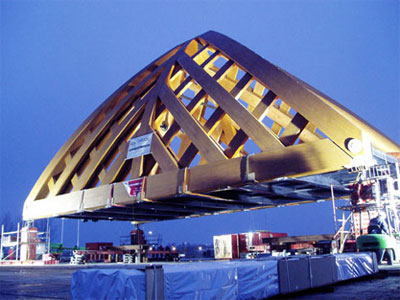
Synchronous Lift System Puts Up Unique Wooden Bridge
Product News Wednesday, February 4, 2009: Enerpac
At the end of November 2008, a 360 tonne wooden bridge was positioned over the A7 national trunk road near Akkerwinde in Sneek (the Netherlands), completing the first phase of a unique project. Prior to being transported with SMTPs from the nearby assembly site to its destination, the whole bridge construction was lifted to a height of more than five metres using Enerpac's hydraulic computer-controlled Synchronous Lift System.
The "Rijksweg 7 Sneek" project was commissioned by the Province of Friesland, Rijkswaterstaat Noord Nederland (Ministry of Waterways and Public Works for the northern Netherlands) and the Municipality of Sneek. The project consists of building two wooden bridges over the new southern A7 ring road. Both bridges - which are actually viaducts - form "landmarks" or recognisable features of the town. As part of the first phase, a new bridge was placed in the Akkerwinde location at the end of November. The second bridge is planned for the Molenkrite area. Where and in what capacity the second connection will be built and positioned depends on experiences with the newly positioned bridge in Akkerwinde.
The new bridge consists of a steel deck and two vertical, wooden arches that are 32 metres long and 16 metres high. Bolts and legs join the arches together. The bridge was designed by OAK architecten - a collaboration between the engineering company Ingenieursbureau Oranjewoud in Heerenveen, Achterbosch Architectuur in Leeuwarden and Onix in Groningen. The wooden arches were built by contractor Schaffitzel from Schwäbisch Hall in Germany. Wagenborg Nedlift from Groningen was responsible for assembly, lifting, transport and positioning. The bridges are an example of progressive architecture, of which the term "durability" is an important element, alongside aesthetic and structural criteria. This applies to both the materials used and the lifespan.
What makes the bridge unique is the wooden arches and its use. Whilst there are already a few modern wooden bridges in the world, none of them until now have been built to such a scale and to support all traffic.
Laminated cribbing blocks made of Accoya® wood measuring 1080 x 1400 mm were used for the arches. This type of wood comes from production forests in New Zealand and is produced and supplied by the Dutch company Titan Wood. Following the process of acetylation, the wood naturally absorbs less moisture, therefore increasing its durability. The German manufacturer Schaffitzel guarantees a lifespan of 80 years for this wood, as long as it is properly maintained.
